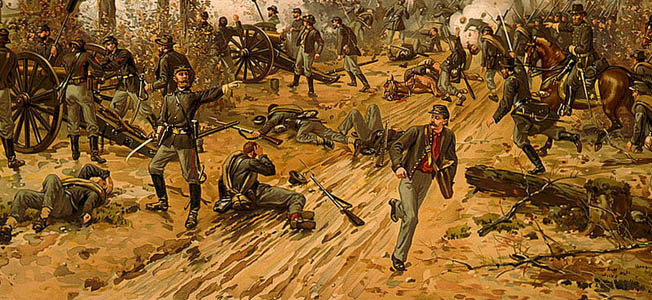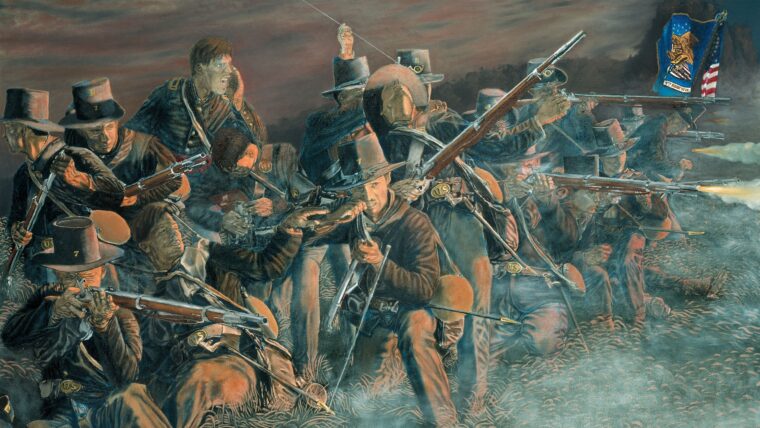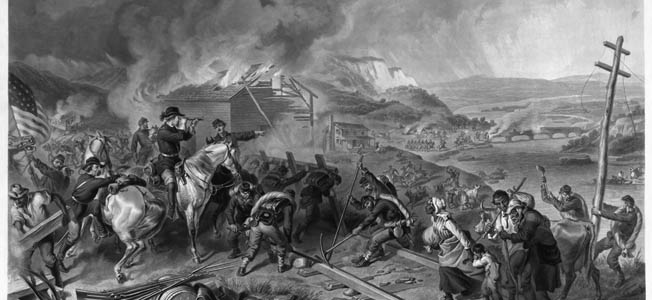
Union Army
Flanks vs. Frontal Attacks: Meade and Lee’s Tactics
by Robert SuhrAll day on July 4, 1863 the Union and Confederate armies stared at each other during the Battle of Gettysburg. Read more

Union Army
All day on July 4, 1863 the Union and Confederate armies stared at each other during the Battle of Gettysburg. Read more

Union Army
Louisiana held an interesting political climate during the American Civil War. It was a prominent slave state; by 1860, nearly half of Louisiana’s population came from slaves. Read more

Union Army
During the Battle of Williamsburg, Virginia, in May 1862, General Joseph Hooker’s Union forces were in pursuit of the withdrawing Confederates. Read more

Union Army
No one expected this—not the fiercest “fire-eater” in South Carolina or the flintiest abolitionist in New England. Read more

Union Army
On this day in 1861, Union and Confederate forces met at the Battle of Philippi in modern day West Virginia. (The area still belonged to Virginia during the early years of the Civil War.) Read more

Union Army
In selecting a leader for the attack on Fort Stedman, Robert E. Lee could scarcely have chosen a better commander than Maj. Read more

Union Army
Much of the American Civil War can be understood through military correspondence, army documents and letters. But to understand the social impact of the bloodiest battles in the nation’s history, researchers and citizens alike often turn to what was then a budding technology: photography. Read more

Union Army
Strategically isolated from the South, geographically isolated from the Far West, and separated from the Union plains states by the Indian Territory (present-day Oklahoma), Texas was a backwater whose ultimate fate depended on the success of the Confederacy. Read more

Union Army
The ground around Manassas, Virginia, was not auspicious for Union Army forces in the first two years of the Civil War. Read more

Union Army
In celebration of the sesquicentennials of General William T. Sherman’s Atlanta Campaign and March to the Sea, the Southern Museum of Civil War and Locomotive History is opening a special exhibit titled “1864.” Read more

Union Army
According to a CNN article, 2014 was the 150 anniversary of “the peak year of suffering” in American Civil War prisons. Read more

Union Army
1861 to 1865 marked a bitter time in U.S. history. Arguments over states’ rights, slavery and the role the federal goverment should play in national affairs brought both the North an South into a terrible conflict that became the American Civil War. Read more
Union Army
For General Philiip Sheridan, war was a tonic.
“He was a wonderful man on the battle field,” one of his fellow Union officers recalled, “and never in as good humor as when under fire.” Read more

Union Army
Shortly after midnight on the morning of April 12, 1861, four men in a rowboat made their way across the pitch-black harbor at Charleston, South Carolina, toward Fort Sumter, an unfinished and architecturally insignificant masonry fort three miles out from the city where the harbor meets the Atlantic Ocean. Read more

Union Army
It isn’t how most would characterize William T. Sherman’s famous march across Georgia in 1864, but Thomas Ricks of Stars and Stripes begs to differ. Read more
Union Army
Seen from the Atlantic coast, the task of Northern armies appeared (at least to a skeptic) almost impossible, for the South looked truly boundless, an ocean of fields, valleys, mountains, forests, and rivers. Read more

Union Army
Following his greatest victory at the Battle of Chancellorsville on May 2, 1863, Confederate Lt. Gen. Thomas J. “Stonewall” Jackson was scouting ahead of the lines with members of his staff when tragedy struck. Read more

Union Army
The first camps assembled by the Union Army of the Potomac were tent cities, thrown together hastily as new regiments arrived from the free states. Read more

Union Army
In the wake of the humiliating and unexpected defeat, and fourth in a line that stretched back to Fort Sumter, the Battle of Bull Run, and the Battle of Wilson’s Creek, the Union Congress created a seven-man Joint Committee on the Conduct of the War to oversee and review all battles and the events surrounding them. Read more

Union Army
The Confederate attack on Fort Sumter on April 12, 1861, marked the beginning of the American Civil War. Read more